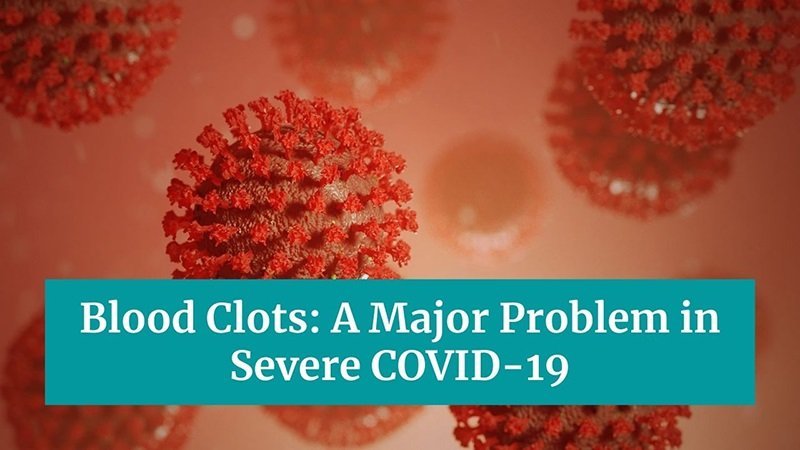The coronavirus disease pandemic has wreaked havoc on every aspect of human life. COVID outbreak has led to many complications. In this ongoing global pandemic, there is an urgent need to understand the rate of bleeding and thrombotic manifestations associated with COVID-19 coagulopathy, as well as the clinical utility of testing abnormal coagulation to predict risk for thrombosis, bleeding and severity of illness. There are many factors that led to blood clotting in COVID-19.
The presence of comorbidities such as diabetes mellitus, hypertension, chronic obstructive pulmonary disease or old age leads to poorer clinical outcomes in COVID-19 patients as there are high chances of formation of blood clots in COVID-19 patients. From day- to- day experience, we can say that COVID-19 and blood clots are inter-related. A high number of thrombotic episodes are reported. Initially, it was recognized as an acute respiratory distress syndrome but soon it was also realized that there is also an involvement of heart, brain and kidney in coronavirus disease. The comorbidities in COVID-19 may be associated with susceptibility to thrombosis.Diabetic patients who develop COVID-19 seem to be at a higher risk of thrombosis. Pregnant women infected with coronavirus have also an increased risk of placental thrombosis.
Though several viruses are linked to the haemorrhagic fevers. There are a few viruses known to cause thrombosis.
Various researches are going on globally on COVID-19, and it is discovered that it is largely a vascular disease. This means that this virus is attacking the blood vessels as much as it is attacking the lungs. In medical terms, clot is known as thrombosis. This is the final product that is formed by the process of coagulation. If these clots were to develop on their own inside the blood vessels, rather than in response to an external injury, this will lead to form a cast inside the blood vessel and cut off the blood circulation to a certain organ. Blood clotting in COVID-19 is particularly high in moderate to severe COVID-19 patients. The virus also attacks the inner lines of the blood vessels. Some of the problems that are common in lungs are due to micro thrombosis i.e., small clots in blood vessels.
COVID-19 patients are reported to suffer from hypoxemia, particularly in the conditions associated with high glycosylated haemoglobin. In the early stages of the coronavirus disease, lung compliance is not reduced during mechanical ventilation. The loss of oxygen transfer capacity haemoglobin and impaired gas exchange in the alveoli with microthrombi is the main reason because microthrombi may cause altered lung perfusion and hypoxic vasoconstriction which worsens the hypoxemia.
How Long does it take to Develop such Blood Clots after the Patient Got Infected with COVID-19?
The blood clots can appear in the first and second week after the patient has contracted COVID-19.
How Blood Clots are Detected in COVID-19?
Venous thromboembolism is frequent in COVID-19.
- Deep Vein Thrombosis is detected by Doppler Ultrasound in COVID-19 patients with pneumonia and elevated D-dimer.
- It was found that patients with COVID-19 have high levels of C-reactive protein (CRP)>100, Erythrocyte Sedimentation Rate (ESR)> 40mm/h.
- Therefore, ESR, CRP, fibrinogen, ferritin and procalcitonin are higher in patients with thrombotic complications than in those without.
- Thus, elevations in D-dimer, platelet count, CRP and ESR at initial presentation are predictive of thrombotic complications during hospitalization.
Till now, there is no treatment of COVID-19 so taking precautions is the ultimate solution. The science of Ayurveda can help in the prevention of coronavirus disease. Ayurveda recommends keeping the digestive fire strong and practice of pranayama for the prevention of COVID-19.
- The strong digestive fire helps in maintaining strong immune system.
- By practicing pranayama, we can clean our pranavaha srotas and it boosts our energy.
- Keep checking your oxygen saturation levels. If it is getting dropped, immediately seek medical help.
Conclusion
Thus, it can be concluded that COVID-19 is associated with similar rates of thrombosis as seen in hospitalized patients with similar degrees of critical illness. Elevated D-dimer levels at initial presentation can predict bleeding complications, thrombotic complications, critical illness as well as death. Beyond D-dimer, thrombosis was primarily associated with inflammatory markers rather than coagulation parameters.








